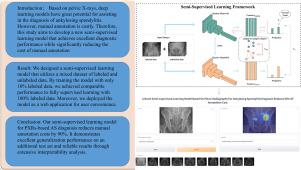A novel semi-supervised learning model based on pelvic radiographs for ankylosing spondylitis diagnosis reduces 90% of annotation cost
IF 6.3
2区 医学
Q1 BIOLOGY
引用次数: 0
Abstract
Objective:
Our study aims to develop a deep learning-based Ankylosing Spondylitis (AS) diagnostic model that achieves human expert-level performance using only a minimal amount of labeled samples for training, in regions with limited access to expert resources.
Methods:
Our semi-supervised diagnostic model for AS was developed using 5389 pelvic radiographs (PXRs) from a single medical center, collected from March 2014 to April 2022. The dataset was split into a training set and a validation set with an 8:2 ratio, allocating 431 labeled images and the remaining 3880 unlabeled images for semi-supervised learning. The model’s performance was evaluated on 982 PXRs from the same center, assessing metrics such as AUC, accuracy, precision, recall, and F1 scores. Interpretability analysis was performed using explainable algorithms to validate the model’s clinical applicability.
Results:
Our semi-supervised learning model achieved accuracy, recall, and precision values of 0.891, 0.865, and 0.859, respectively, using only 10% of labeled data from the entire training set, surpassing human expert performance. Extensive interpretability analysis demonstrated the reliability of our model’s predictions, making the deep neural network no longer a black box.
Conclusion:
This study marks the first application of semi-supervised learning to diagnose AS using PXRs, achieving a 90% reduction in manual annotation costs. The model showcases robust generalization on an independent test set and delivers reliable diagnostic performance, supported by comprehensive interpretability analysis. This innovative approach paves the way for training high-performance diagnostic models on large datasets with minimal labeled data, heralding a cost-effective future for medical imaging research in big data analytics.

基于骨盆X光片诊断强直性脊柱炎的新型半监督学习模型可减少90%的标注成本。
目的:我们的研究旨在开发一种基于深度学习的强直性脊柱炎(AS)诊断模型:我们的研究旨在开发一种基于深度学习的强直性脊柱炎(AS)诊断模型,在专家资源有限的地区,只需使用极少量的标注样本进行训练,就能达到人类专家水平:我们的强直性脊柱炎半监督诊断模型是利用一个医疗中心从 2014 年 3 月至 2022 年 4 月收集的 5389 张骨盆 X 光片(PXR)开发的。数据集以 8:2 的比例分为训练集和验证集,其中 431 张标注图像和其余 3880 张未标注图像用于半监督学习。在同一中心的 982 张 PXR 上对模型的性能进行了评估,评估指标包括 AUC、准确度、精确度、召回率和 F1 分数。使用可解释算法进行了可解释性分析,以验证模型的临床适用性:结果:我们的半监督学习模型仅使用了整个训练集中 10% 的标记数据,准确率、召回率和精确率就分别达到了 0.891、0.865 和 0.859,超过了人类专家的表现。广泛的可解释性分析证明了我们模型预测的可靠性,使深度神经网络不再是一个黑盒子:本研究首次将半监督学习应用于使用 PXRs 诊断强直性脊柱炎,将人工标注成本降低了 90%。该模型在独立测试集上展示了强大的泛化能力,并在全面的可解释性分析支持下提供了可靠的诊断性能。这种创新方法为在大型数据集上用最少的标注数据训练高性能诊断模型铺平了道路,预示着大数据分析医学影像研究的成本效益未来。
本文章由计算机程序翻译,如有差异,请以英文原文为准。
求助全文
约1分钟内获得全文
求助全文
来源期刊

Computers in biology and medicine
工程技术-工程:生物医学
CiteScore
11.70
自引率
10.40%
发文量
1086
审稿时长
74 days
期刊介绍:
Computers in Biology and Medicine is an international forum for sharing groundbreaking advancements in the use of computers in bioscience and medicine. This journal serves as a medium for communicating essential research, instruction, ideas, and information regarding the rapidly evolving field of computer applications in these domains. By encouraging the exchange of knowledge, we aim to facilitate progress and innovation in the utilization of computers in biology and medicine.
 求助内容:
求助内容: 应助结果提醒方式:
应助结果提醒方式:


